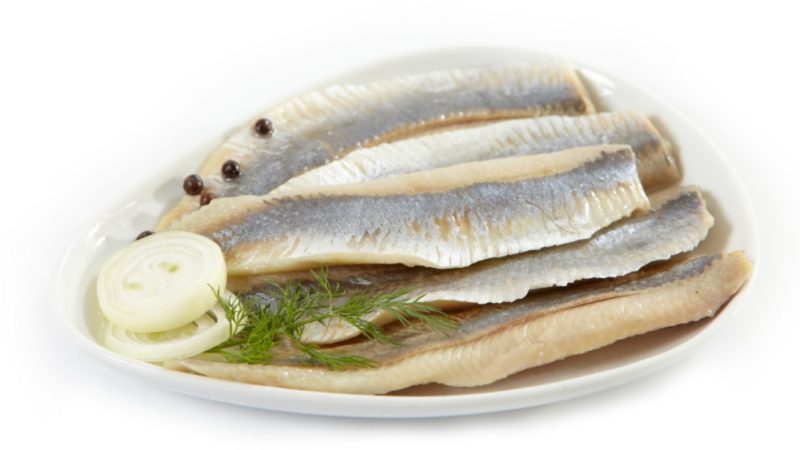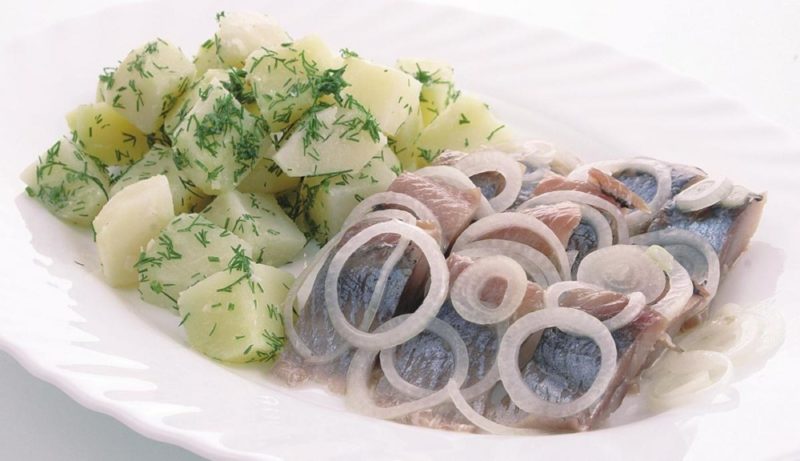Salted herring contains easily digestible proteins, healthy fats, micronutrients are preserved unchanged, so it is included in the healthy nutrition program. Before making a diet, it is useful to find out how many calories are in salted herring, caviar and milk.
Material Content:
Chemical composition and nutritional value of fish
Herring consists of 18% protein, which includes 18 amino acids, including all 9 essential ones. Fats account for 9 to 19.5%, depending on the herring variety. The main part of fat is mono- and polyunsaturated acids; 100 g of herring contains 2–2.4 g of Omega 3. The remaining fish components are water and 1.5 g of ash, there are no carbohydrates in it.
Herring includes a complex of beneficial micronutrients. The table indicates their content in 100 g of fish in decreasing order of concentration and percentage relative to the average daily requirement of an adult.
| Vitamins | Minerals and minerals | ||||
|---|---|---|---|---|---|
| Title | Mg amount | % of normal | Title | Mg amount | % of normal |
| B4 | 65 | 13 | Potassium | 327 | 13 |
| PP | 3,2 – 7,8 | 16 – 39 | Phosphorus | 236 | 30 |
| E | 1 – 1,2 | 7 – 8 | Sodium | 90 | 7 |
| C | 0,7 | 0,8 | Calcium | 57 | 6 |
| B5 | 0,6 | 13 | Magnesium | 32 | 8 |
| B6 | 0,3 | 15 | Iron | 1,1 | 6 |
| B2 | 0,2 | 13 | Zinc | 1 | 8 |
| B1 | 0,09 | 6 | Copper | 0,092 | 9 |
| A | 0,028 | 3 | Selenium | 0,036 | 66 |
| B12 | 0,013 | 455 | Manganese | 0,035 | 2 |
| B9 | 0,01 | 2,5 | Iodine | 0,04 | 26 |
| D | 0,004 – 0,03 | 42 – 300 | Fluorine | 0, 038 | 9,5 |
| K | 0,001 | 0,1 | Chromium | 0,055 | 110 |
The content of vitamins D, PP, E increases in proportion to the degree of fat content.
How many calories are in salted herring
The energy value of herring depends on the environment: the more favorable the conditions, the larger, fatter the fish and its calorie content. 100 g of low-fat Atlantic and Pacific salted herring fillets contain 135 kcal, in fatty varieties - 190–246.
Salt increases the calorie content of fish. When salting, water leaves, while the density and energy value of the final product increases.
Caloric content is affected by the method of preparation and additives:
- 100 g of lightly salted fish of medium fat content contains 145 kcal;
- pickled with vinegar, spices - 190;
- in tomato sauce - 159;
- with mayonnaise - 320.
- in herring with butter and onions - 300.
In 100 g of herring under a fur coat, cooked according to a traditional recipe, contains from 110 to 190 kcal, depending on the amount of mayonnaise.
Calorie milk and caviar
Caviar is a cluster of unfertilized eggs of females; 100 g contains 31 g of protein and 10 g of fat. Energy value is 222 kcal. At the same time, 100 g of the product covers the average daily need for polyunsaturated acids Omega 3, phosphorus, and the amount of vitamins B2 and D even exceeds the daily norm. Caviar contains 47% of the daily norm of tocopherol, 73% of selenium, 15% of iron.
Milk - the seminal fluid of males, consists of 22% protein and 6.4% fat, calories - 140 kcal. It contains a triple daily rate of vitamin D. Caviar and milk are often recommended during the recovery period after surgery or a serious illness.
Benefits and harm to the body
The use of salty herring is due to the valuable properties of the individual components:
- Proteins from it are easier to digest than from meat or dairy products.
- Herring fats do not harm the body because they contain polyunsaturated acids. 100 g of herring replenish the average daily rate of Omega 3, they increase the concentration of high density lipoproteins, remove "bad" cholesterol, prevent blood clots in the vessels, and stimulate blood flow.
- Vitamin D promotes the absorption of calcium, without this mineral it is impossible to form normal bone tissue, teeth. It is useful to include herring in the diet in winter with a shortage of sunlight. A 30-gram slice of oily herring contains the daily rate of calciferol.
- Vitamin PP is involved in dozens of biochemical processes, supports healthy hair, skin, regulates the digestive tract, cardiovascular, nervous system.
- Iron increases the concentration of hemoglobin in the blood, prevents the development of anemia.
- Vitamin B2 strengthens the mucous membrane of the eye, protects against the harmful effects of ultraviolet rays.
- Selenium is rarely found in foods, this microelement regulates cell division, slows down the aging of the body.
- Chromium is involved in carbohydrate metabolism, maintains normal blood sugar levels. The trace element breaks down low-density lipids and reduces the risk of developing cardiovascular disease.
- Vitamin B4 prevents the formation of fat in the liver, removes excess cholesterol.
- Iodine regulates metabolism, water-electrolyte, hormonal balance, maintains normal body temperature, weight, stimulates the formation of phagocytes and strengthens the immune system.
- Phosphorus is responsible for the development of bones and teeth, biochemical compounds with this mineral are involved in the transmission of nerve impulses, protein and carbohydrate metabolism.
- Vitamin B12 affects blood formation, stimulates the formation of red blood cells, and regulates the function of nerve fibers.
- Herring accumulates less harmful substances than other fish. It is less commonly grown under artificial conditions, and more slowly absorbs salts of heavy metals from the environment.
Possible harm is associated not with fish, but with the content of salt in it. Herring is advised to limit people with impaired renal function, heart, with a tendency to edema. The fat of this product quickly oxidizes when stored improperly, which is noticeable by yellowish spots on the surface.
Salted fish is a good source of protein, it is useful to introduce it into the diet to supplement high-density lipids, vitamins, minerals, trace elements. The calorie content of salted herring depends on the fat content, method of preparation, composition and amount of included additives.















